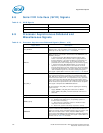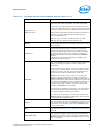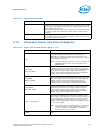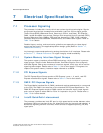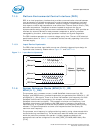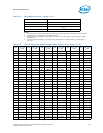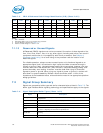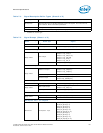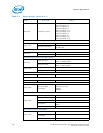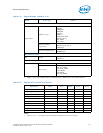
Electrical Specifications
130 Intel® Xeon® Processor E5-1600 v2/E5-2600 v2 Product Families
Datasheet Volume One of Two
7.1.9.2 Decoupling Guidelines
Due to its large number of transistors and high internal clock speeds, the processor is
capable of generating large current swings between low and full power states. This may
cause voltages on power planes to sag below their minimum values if bulk decoupling is
not adequate. Large electrolytic bulk capacitors (C
BULK
), help maintain the output
voltage during current transients, for example coming out of an idle condition. Care
must be taken in the baseboard design to ensure that the voltages provided to the
processor remain within the specifications listed in Table 7-11. Failure to do so can
result in timing violations or reduced lifetime of the processor.
7.1.9.3 Voltage Identification (VID)
The Voltage Identification (VID) specification for the V
CC,
V
SA
, V
CCD
voltage are defined
by the compatible VR12.0 PWM controller. The reference voltage or the VID setting is
set via the SVID communication bus between the processor and the voltage regulator
controller chip. The VID settings are the nominal voltages to be delivered to the
processor's V
CC,
V
SA
, V
CCD
lands. Table 7-3 specifies the reference voltage level
corresponding to the VID value transmitted over serial VID. The VID codes will change
due to temperature and/or current load changes in order to minimize the power and to
maximize the performance of the part. The specifications are set so that a voltage
regulator can operate with all supported frequencies.
Individual processor VID values may be calibrated during manufacturing such that two
processor units with the same core frequency may have different default VID settings.
The processor uses voltage identification signals to support automatic selection of V
CC,
V
SA
, and V
CCD
power supply voltages. If the processor socket is empty (SKTOCC_N
high), or a “not supported” response is received from the SVID bus, then the voltage
regulation circuit cannot supply the voltage that is requested, the voltage regulator
must disable itself or not power on. Vout MAX register (30h) is programmed by the
processor to set the maximum supported VID code and if the programmed VID code is
higher than the VID supported by the VR, then VR will respond with a “not supported”
acknowledgement. See the compatible VR12.0 PWM controller
for further details.
7.1.9.3.1 SVID Commands
The processor provides the ability to operate while transitioning to a new VID setting
and its associated processor voltage rails (V
CC,
V
SA
, and V
CCD
). This is represented by a
DC shift. It should be noted that a low-to-high or high-to-low voltage state change may
result in as many VID transitions as necessary to reach the target voltage. Transitions
above the maximum specified VID are not supported. The processor supports the
following VR commands:
V
CCD_01
V
CCD_23
51
Each V
CCD
land is connected to a switchable 1.50 V and 1.35 V supply,
provide power to the processor DDR3 interface. These supplies also
power the DDR3 memory subsystem. V
CCD
is also controlled by the
SVID Bus. V
CCD
is the generic term for V
CCD_01
, V
CCD_23
.
V
TTA
14 V
TTA
lands must be supplied by a fixed 1.0V supply.
V
TTD
19 V
TTD
lands must be supplied by a fixed 1.0V supply.
V
SA
25
Each V
SA
land must be supplied with the voltage determined by the
SVID Bus signals, typically set at 0.940V. VSA has a VBOOT setting of
0.9V.
V
SS
548 Ground
Table 7-1. Power and Ground Lands (Sheet 2 of 2)
Power and
Ground Lands
Number of
Lands
Comments



